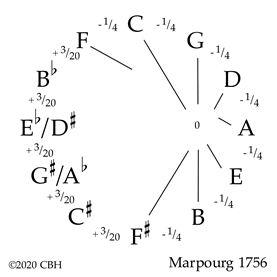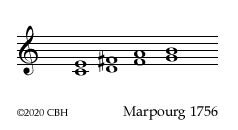Technical Library
TEMPERAMENTS XIII: Marpourg
Entire Contents Copyright © 2020 CBHTechnical LibraryTEMPERAMENTS XIII: Marpourg Entire Contents Copyright © 2020 CBH |

 WIKIMEDIA COMMONS / PUBLIC DOMAIN |
| Friedrich Wilhelm Marpourg (1718–1795) |
Rameau’s temperament was all very well, with its chain of seven Quarter-comma narrow fifths in a row producing four pure Major thirds—if you didn’t mind his split wolf of two rather wide fifths.
In the first chapter of his Principes de clavecin published in Berlin in 1756, Friedrich Wilhelm Marpourg (1718–1795) gave directions for tuning l‘égalité du tempérament (Equal Temperament), dividing the octave into four equally-sounding Major thirds C–E, E–G♯, & A♭–C and proceeding from there. He acknowledged that this scheme was derived from “the famous Mr Sorge, good harmonist and clever mathematician”.
However, Marpourg then stated that some people would have difficulty coming to terms with this new method of tuning, so he followed with instructions for tuning in the current fashion of unequal temperament. Like Rameau suggested thirty years previously, Marpourg used a chain of seven Quarter-comma narrow fifths, but starting from F. And instead of splitting the wolf in two and having a few pure fifths, Marpourg eliminated the wolf by dividing the error equally in the five remaining, slightly-wide fifths between F and F♯. As a result, the accidentals become true compromizes. There are still four pure Major thirds, but if you begin to stray from your pure keys, you’ll notice the color changes rapidly. At least there’s no wolf!
To change your usual Quarter-comma meantone to the Marpourg temperament, you need change only four accidentals:
1. Tune your b♭ a pure fifth below f', then keep lowering the b♭ until it has a clearly noticeable beat, not quite twice per second. The interval must be wide by almost a sixth of a comma—the same discrepancy as a Vallotti-tempered fifth is narrow. There’s no need to fuss or panic about this: Just so long as your interval is a wide with a good beat, you are probably just fine.
 2. Find your e♭ a pure fifth below b♭,
then again expand the interval by lowering the e♭ until you
hear a lazy beat, about once per second. This will produce your E♭/D♯ compromize. Tune up an octave to e♭'.
2. Find your e♭ a pure fifth below b♭,
then again expand the interval by lowering the e♭ until you
hear a lazy beat, about once per second. This will produce your E♭/D♯ compromize. Tune up an octave to e♭'.
3. Now work from your f♯, and raise the c♯' above until the fifth is pure and then raise it some more so you have a definite beat, albeit a bit slower than your b♭–f' because it is slightly lower on the keyboard. Tune down an octave to c♯.
4. All that remains is to determine your G♯/A♭ compromize. Tune a pure fifth from c♯ up to g♯ and stretch the interval until it has a gentle beat, about once per second. It should have a similar flavor to the same-sized fifth you have just tuned only a tone higher, e♭–b♭. Likewise, the a♭–e♭' (or g♯–d♯' if you prefer) must be wide. If necessary, juggle your accidentals a bit until you are happy that the fifths are equally wide, always bearing in mind that intervals the same theoretical size beat faster as you ascend the keyboard: c♯–g♯, e♭–b♭, f♯–c♯', a♭–e♭' and b♭–f'.
Look, Marpourg—no wolf and still four pure Major thirds!
There are many other meantone possibilities: Let’s look next at a famous modern player’s version of an English Ord temperament.
To tune Marpourg from scratch, follow these steps:
1. Tune a' to your pitch source, and tune a an absolute pure octave below it.
2. Tune a pure f–a third, and divide it into four quarter-comma narrow fifths, making f–c', g–d', c'–g' and d'–a' sound equally rough.
3. Three more pure thirds are determined from notes you have already tuned: Tune b a pure third above g; your e' above c', and f♯' above d'.
4. Tune your b♭ a pure fifth below f', then keep lowering the b♭ until it has a clearly noticeable beat, not quite twice per second.
5. Find your e♭ a pure fifth below b♭, then again expand the interval by lowering the e♭ until you hear a lazy beat, about once per second. Tune up an octave to e♭'.
6. Tune f♯ down an octave from f♯'. Tune c♯' a pure fifth above f♯ and then raise it so you have a definite beat, albeit a bit slower than your b♭–f' . Tune down an octave to c♯.
7. Determine your G♯/A♭ compromize by tuning a pure fifth from c♯ up to g♯ and then stretching the interval until it has a gentle beat, again about once per second.
Further discussion
Asselin, Pierre-Yves Musique et Tempérament Éditions Costallat, Paris 1985, p117
| Pitch nomenclature | |
| Harpsichord Tuning Process | |
| Tuning Bibliography | |
| Technical Library overview | |
| Harpsichords Australia Home Page |